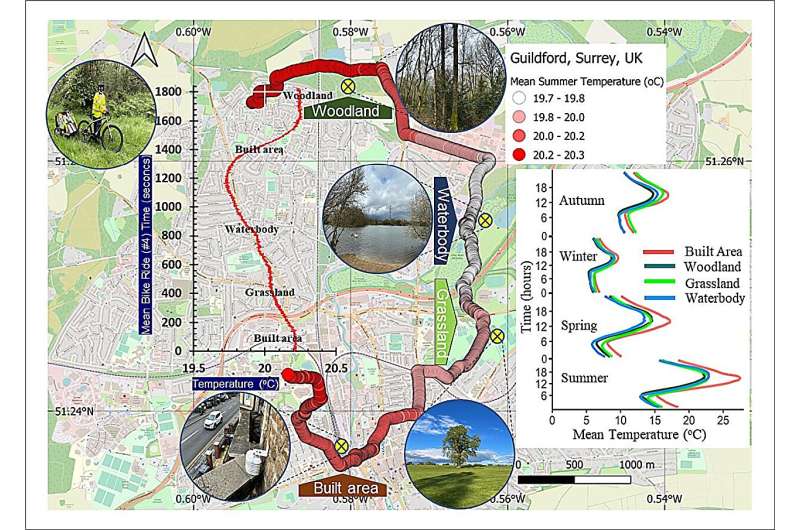This article has been reviewed according to Science X's editorial process and policies. Editors have highlighted the following attributes while ensuring the content's credibility:
fact-checked
peer-reviewed publication
trusted source
proofread
Scientists call for a tree planting drive to help tackle heat waves

Adding more natural areas across our towns and cities could cool them by up to 6°C during heat waves, according to new research from the University of Surrey's Global Centre for Clean Air Research (GCARE).
After a year of monitoring temperatures in four distinct areas of Guildford, England, researchers found that nature-based locations—woodlands, grasslands, and lakes—were up to 3°C cooler on average than built-up areas.
Researchers from the GCARE are now urging town and city planners to focus on adding 'green' and 'blue' areas to help combat increasingly frequent annual heat waves.
Professor Prashant Kumar, co-author of the study and Founding Director of GCARE, is endorsing a national tree-planting and nature-based solutions initiative:
"With global temperatures soaring and the UK recording its hottest-ever temperature in July 2022, our research adds to the growing body of evidence that confirms that nature is the key to keeping our urban areas cool."
"We recommend planting trees in as many public spaces as possible, especially around our schools, as a great starting point to help communities tackle the urban heat island effect. Water bodies, such as lakes and ponds, can also help cool areas, and could be useful for managing excess stormwater."
Researchers monitored temperatures continuously from June 2021 until the end of August 2022, with temperature sensors placed two to three meters above ground level. The sensors captured data every minute, taking 633,780 readings in total.
Researchers found that during the summer of 2022, there was an increased likelihood of more intense and longer-lasting heat waves compared to 2021. The built-up area frequently exceeded the heat wave threshold of 28°C. On 19 July 2022, which was the most extreme day of the year and the hottest day ever recorded in the UK, the temperature soared to 40.7°C.
Professor Kumar added, "We want our data to help build city-scale environmental models and assist planners and ordinary citizens in incorporating natural elements into built-up areas. This work aligns with Sustainable Development Goals 11 (sustainable cities and communities) and 13 (climate action)."
The study has been published in Environment International.
More information: Jeetendra Sahani et al, Efficacy assessment of green-blue nature-based solutions against environmental heat mitigation, Environment International (2023). DOI: 10.1016/j.envint.2023.108187
Journal information: Environment International
Provided by University of Surrey





















